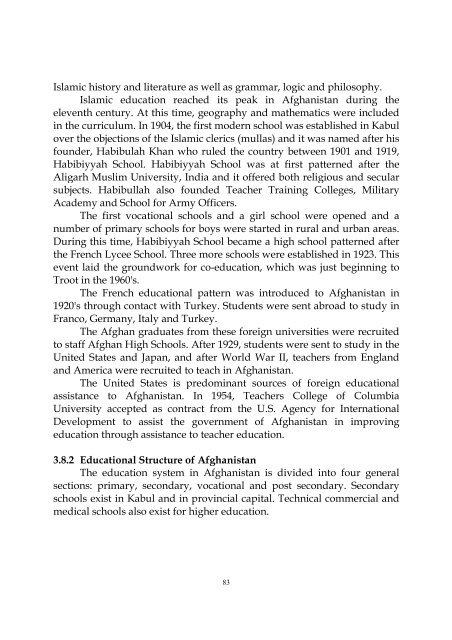edu 304 - comparative education - National Open University of Nigeria
edu 304 - comparative education - National Open University of Nigeria
edu 304 - comparative education - National Open University of Nigeria
Create successful ePaper yourself
Turn your PDF publications into a flip-book with our unique Google optimized e-Paper software.
Islamic history and literature as well as grammar, logic and philosophy.<br />
Islamic <strong>edu</strong>cation reached its peak in Afghanistan during the<br />
eleventh century. At this time, geography and mathematics were included<br />
in the curriculum. In 1904, the first modern school was established in Kabul<br />
over the objections <strong>of</strong> the Islamic clerics (mullas) and it was named after his<br />
founder, Habibulah Khan who ruled the country between 1901 and 1919,<br />
Habibiyyah School. Habibiyyah School was at first patterned after the<br />
Aligarh Muslim <strong>University</strong>, India and it <strong>of</strong>fered both religious and secular<br />
subjects. Habibullah also founded Teacher Training Colleges, Military<br />
Academy and School for Army Officers.<br />
The first vocational schools and a girl school were opened and a<br />
number <strong>of</strong> primary schools for boys were started in rural and urban areas.<br />
During this time, Habibiyyah School became a high school patterned after<br />
the French Lycee School. Three more schools were established in 1923. This<br />
event laid the groundwork for co-<strong>edu</strong>cation, which was just beginning to<br />
Troot in the 1960's.<br />
The French <strong>edu</strong>cational pattern was introduced to Afghanistan in<br />
1920's through contact with Turkey. Students were sent abroad to study in<br />
Franco, Germany, Italy and Turkey.<br />
The Afghan graduates from these foreign universities were recruited<br />
to staff Afghan High Schools. After 1929, students were sent to study in the<br />
United States and Japan, and after World War II, teachers from England<br />
and America were recruited to teach in Afghanistan.<br />
The United States is predominant sources <strong>of</strong> foreign <strong>edu</strong>cational<br />
assistance to Afghanistan. In 1954, Teachers College <strong>of</strong> Columbia<br />
<strong>University</strong> accepted as contract from the U.S. Agency for International<br />
Development to assist the government <strong>of</strong> Afghanistan in improving<br />
<strong>edu</strong>cation through assistance to teacher <strong>edu</strong>cation.<br />
3.8.2 Educational Structure <strong>of</strong> Afghanistan<br />
The <strong>edu</strong>cation system in Afghanistan is divided into four general<br />
sections: primary, secondary, vocational and post secondary. Secondary<br />
schools exist in Kabul and in provincial capital. Technical commercial and<br />
medical schools also exist for higher <strong>edu</strong>cation.<br />
83
















